Publish Date: Aug 16, 2021 | Keywords: Climate change, Clothing, Comfort, Comfort Congress 2021, Perception, Publications
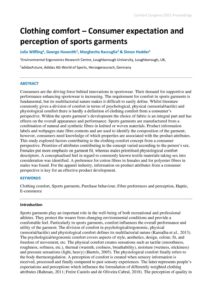 |
Author
Julia Wilfling, George Havenith, Margherita Raccuglia & Simon Hodder |
Abstract
Consumers are the driving force behind innovations in sportswear. Their demand for supportive and performance enhancing sportswear is increasing. The requirement for comfort in sports garments is fundamental, but its multifactorial nature makes it difficult to easily define. Whilst literature commonly gives a division of comfort in terms of psychological, physical (sensorial/tactile) and physiological comfort there is hardly a definition of clothing comfort from a consumer’s perspective. Within the sports garment’s development the choice of fabric is an integral part and has effects on the overall appearance and performance. Sports garments are manufactured from a combination of natural and synthetic fibres in knitted or woven materials. Product information labels and webpages state fibre contents and are used to identify the composition of the garment; however, consumers need knowledge of which properties are associated with the product attributes. This study explored factors contributing to the clothing comfort concept from a consumer perspective. Priorities of attributes contributing to the concept varied according to the person’s sex. Females put more emphasis on garment fit, whereas males prioritised physiological comfort descriptors. A conceptualised feel in regard to commonly known textile materials taking sex into consideration was identified. A preference for cotton fibres in females and for polyester fibres in males was found. For the apparel industry, information on product attributes from a consumer perspective is key for an effective product development. |
Publish Date: Aug 12, 2021 | Keywords: Automotive, Comfort, Comfort Congress 2021, Fatigue & sleep, Publications
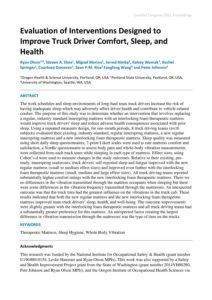 |
Author
Ryan Olson, Steven A. Shea, Miguel Marino, Jarred Rimby, Kelsey Womak, Rachel Springer, Courtney Donovan, Sean P.M. Rice Fangfang Wang & Peter Johnson |
Abstract
The work schedules and sleep environments of long-haul team truck drivers increase the risk of having inadequate sleep which may adversely affect driver health and contribute to vehicle-related crashes. The purpose of this study was to determine whether an intervention that involves replacing a regular, industry-standard innerspring mattress with an interlocking foam therapeutic mattress would improve truck drivers' sleep and reduce adverse health consequences associated with poor sleep. Using a repeated measures design, for one-month periods, 8 truck driving teams (n=16 subjects) evaluated their existing, industry-standard, regular innerspring mattress, a new regular innerspring mattress and a new interlocking foam therapeutic mattress. Sleep quality was measured using short daily sleep questionnaires, 7-point Likert scales were used to rate mattress comfort and satisfaction, a Nordic questionnaire to assess body pain and whole-body vibration measurements were collected from each truck team while sleeping in each type of mattress. Effect sizes, using Cohen’s-d were used to measure changes in the study outcomes. Relative to their existing, pre-study, innerspring mattresses, truck drivers' self-reported sleep and fatigue improved with the new regular mattress (small to medium effect sizes) and improved even further with the interlocking foam therapeutic mattress (small, medium and large effect sizes). All truck driving teams reported substantially higher comfort ratings with the new interlocking foam therapeutic mattress. There we no differences in the vibration transmitted through the mattress occupants when sleeping but there were some differences in the vibration frequency transmitted through the mattresses. An unexpected outcome was that the truck tires had the greatest influence on the vibrations in the truck cab. These results indicated that both the new regular mattress and the new interlocking foam therapeutic mattress improved team truck drivers’ sleep, health, and well-being. The outcome improvements were slightly greater with the interlocking foam therapeutic mattress and all truck driving teams had a substantially greater preference for this mattress. An unexpected factor creating the largest difference in vibration transmission through the mattresses was the type of tires on the trucks. |
Publish Date: Aug 9, 2021 | Keywords: Comfort, Fatigue & sleep, Publications
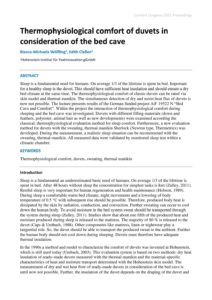 |
Author
Bianca-Michaela Wölfling, Edith Claßen |
Abstract
Sleep is a fundamental need for humans. On average 1/3 of the lifetime is spent in bed. Important for a healthy sleep is the duvet. This should have sufficient heat insulation and should ensure a dry bed climate at the same time. The thermophysiological comfort of classic duvets can be rated via skin model and thermal manikin. The simultaneous detection of dry and moist heat flux of duvets is now not possible. The lecture presents results of the German funded project AiF 19522 N “Bed Cave and Comfort”. Within the project the interaction of thermophysiological comfort during sleeping and the bed cave was investigated. Duvets with different filling materials (down and feathers, polyester, animal hair as well as new developments) were examined according the classical, thermophysiological evaluation method for sleep comfort. Furthermore, a new evaluation method for duvets with the sweating, thermal manikin Sherlock (Newton type, Thermetrics) was developed. During the measurement, a realistic sleep situation can be reconstructed with the sweating, thermal manikin. All measured data were validated by monitored sleep test within a climatic chamber. |
Publish Date: Aug 11, 2021 | Keywords: Automotive, Comfort, Comfort Congress 2021, Publications
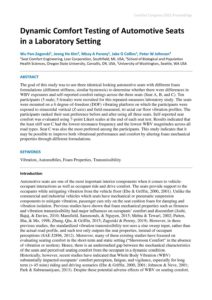 |
Author
Wu Pan-Zagorski, Jeong Ho Kim, Missy A Pereny, Jake G Collins & Peter W Johnson |
Abstract
The goal of this study was to use three identical looking automotive seats with different foam formulations (different stiffness, similar hysteresis) to determine whether there were differences in WBV exposures and self-reported comfort ratings across the three seats (Seat A, B, and C). Ten participants (5 male; 5 female) were recruited for this repeated-measures laboratory study. The seats were mounted on a 6 degree-of-freedom (DOF) vibrating platform on which the participants were exposed to sinusoidal vertical (Z-axis) and field-measured, tri-axial car floor vibration profiles. The participants ranked their seat preference before and after using all three seats. Self-reported seat comfort was evaluated using 7-point Likert scales at the end of each seat test. Results indicated that the least stiff seat C had the lowest resonance frequency and the lowest WBV magnitudes across all road types. Seat C was also the most preferred among the participants. This study indicates that it may be possible to improve both vibrational performance and comfort by altering foam mechanical properties through different formulations. |
Publish Date: Aug 18, 2021 | Keywords: Automation, Comfort, Comfort Congress 2021, Publications, Virtual reality
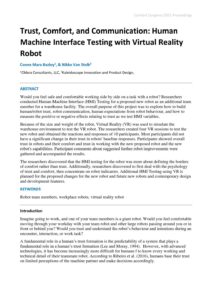 |
Author
Conne Mara Bazley & Nikko Van Stolk |
Abstract
Would you feel safe and comfortable working side by side on a task with a robot? Researchers conducted Human Machine Interface (HMI) Testing for a proposed new robot as an additional team member for a warehouse facility. The overall purpose of this project was to explore how to build human/robot trust, robot communication, human expectations from robot behaviour, and how to measure the positive or negative effects relating to trust as we test HMI variables. Because of the size and weight of the robot, Virtual Reality (VR) was used to simulate the warehouse environment to test the VR robot. The researchers created four VR sessions to test the new robot and obtained the reactions and responses of 10 participants. Most participants did not have a significant change in their trust in robots' baseline responses. Participants showed overall trust in robots and their comfort and trust in working with the new proposed robot and the new robot's capabilities. Participant comments about suggested further robot improvements were gathered and accompanied the results. The researchers discovered that the HMI testing for the robot was more about defining the borders of comfort rather than trust. Additionally, researchers discovered to first deal with the psychology of trust and comfort, then concentrate on robot indicators. Additional HMI Testing using VR is planned for the proposed changes for the new robot and future new robots and contemporary design and development features. |
Publish Date: Aug 10, 2021 | Keywords: Comfort, Comfort Congress 2021, Publications, Seating
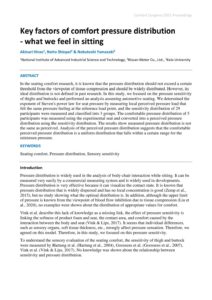 |
Author
Akinari Hirao, Naito Shinpei & Nobutoshi Yamazaki |
Abstract
In the seating comfort research, it is known that the pressure distribution should not exceed a certain threshold from the viewpoint of tissue compression and should be widely distributed. However, its ideal distribution is not defined in past research. In this study, we focused on the pressure sensitivity of thighs and buttocks and performed an analysis assuming automotive seating. We determined the exponent of Steven's power law for seat pressure by measuring local perceived pressure load that felt the same pressure feeling at the reference load point, and the sensitivity distribution of 29 participants were measured and classified into 3 groups. The comfortable pressure distribution of 5 participants was measured using the experimental seat and converted into a perceived pressure distribution using the sensitivity distribution. The results show measured pressure distribution is not the same as perceived. Analysis of the perceived pressure distribution suggests that the comfortable perceived pressure distribution is a uniform distribution that falls within a certain range for the minimum pressure. |
Publish Date: Aug 9, 2021 | Keywords: Autonomous vehicles, Comfort, Comfort Congress 2021, Publications, Seating
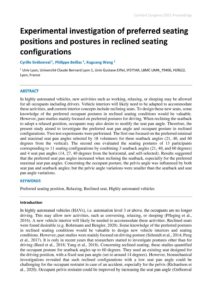 |
Author
Cyrille Grébonval, Philippe Beillas, Xuguang Wang |
Abstract
In highly automated vehicles, new activities such as working, relaxing, or sleeping may be allowed for all occupants including drivers. Vehicle interiors will likely need to be adapted to accommodate these activities, and current interior concepts include reclining seats. To design these new seats, some knowledge of the preferred occupant postures in reclined seating conditions would be valuable. However, past studies mainly focused on preferred postures for driving. When reclining the seatback to adopt a relaxed position, occupants may also desire to modify the seat pan angle. Therefore, the present study aimed to investigate the preferred seat pan angle and occupant posture in reclined configurations. Two test experiments were performed. The first one focused on the preferred minimal and maximal seat pan angles selected by 18 volunteers for three seatback angles (21, 40, and 60 degrees from the vertical). The second one evaluated the seating postures of 13 participants corresponding to 11 seating configurations by combining 3 seatback angles (21, 40, and 60 degrees) and 4 seat pan angles (14, 27, 40 degrees from the horizontal, and self-selected). Results suggested that the preferred seat pan angles increased when reclining the seatback, especially for the preferred maximal seat pan angles. Concerning the occupant posture, the pelvis angle was influenced by both seat pan and seatback angles; but the pelvic angle variations were smaller than the seatback and seat pan angle variations. |
Publish Date: Aug 10, 2021 | Keywords: Anthropometry, Automotive, Autonomous vehicles, Comfort, Comfort Congress 2021, Publications, Seating
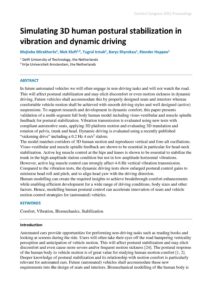 |
Author
Mojtaba Mirakhorlo, Nick Kluft, Tugrul Irmak, Barys Shyrokau & Riender Happee |
Abstract
In future automated vehicles we will often engage in non-driving tasks and will not watch the road. This will affect postural stabilization and may elicit discomfort or even motion sickness in dynamic driving. Future vehicles shall accommodate this by properly designed seats and interiors whereas comfortable vehicle motion shall be achieved with smooth driving styles and well designed (active) suspensions. To support research and development in dynamic comfort, this paper presents validation of a multi-segment full body human model including visuo-vestibular and muscle spindle feedback for postural stabilization. Vibration transmission is evaluated using new tests with compliant automotive seats, applying 3D platform motion and evaluating 3D translation and rotation of pelvis, trunk and head. Dynamic driving is evaluated using a recently published “sickening drive” including a 0.2 Hz 4 m/s2 slalom. The model matches corridors of 3D human motion and reproduces vertical and fore-aft oscillations. Visuo-vestibular and muscle spindle feedback are shown to be essential in particular for head-neck stabilization. Active leg muscle control at the hips and knees is shown to be essential to stabilize the trunk in the high amplitude slalom condition but not in low amplitude horizontal vibrations. However, active leg muscle control can strongly affect 4-6 Hz vertical vibration transmission. Compared to the vibration tests, the dynamic driving tests show enlarged postural control gains to minimise head roll and pitch, and to align head yaw with the driving direction. Human modelling can create the required insights to achieve breakthrough comfort enhancements while enabling efficient development for a wide range of driving conditions, body sizes and other factors. Hence, modelling human postural control can accelerate innovation of seats and vehicle motion control strategies for (automated) vehicles. |
Publish Date: Aug 11, 2021 | Keywords: Automotive, Autonomous vehicles, Comfort, Comfort Congress 2021, Publications, Seating, User experience
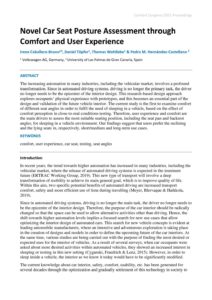 |
Author
Irene Caballero-Bruno, Daniel Töpfer, Thomas Wohllebe & Pedro M. Hernández-Castellano |
Abstract
The increasing automation in many industries, including the vehicular market, involves a profound transformation. Since in automated driving systems, driving is no longer the primary task, the driver no longer needs to be the epicenter of the interior design. This research-based design approach explores occupants’ physical experience with prototypes, and this becomes an essential part of the design and validation of the future vehicle interior. The current study is the first to examine comfort of different seat angles in order to fulfil the need of sleeping in a vehicle, based on the effect of comfort perception in close-to-real conditions testing. Therefore, user experience and comfort are the main drivers to assess the most suitable seating position, including the seat pan and backrest angles, for sleeping in a vehicle environment. Our findings suggest that users prefer the reclining and the lying seats in, respectively, short/medium and long-term use cases. |
Publish Date: Aug 18, 2021 | Keywords: Clothing, Comfort, Comfort Congress 2021, Publications
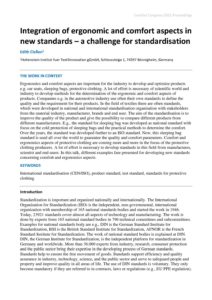 |
Author
Edith Claßen |
Abstract
Ergonomics and comfort aspects are important for the industry to develop and optimize products e.g. car seats, sleeping bags, protective clothing. A lot of effort is necessary of scientific world and industry to develop methods for the determination of the ergonomic and comfort aspects of products. Companies e.g. in the automotive industry use often their own standards to define the quality and the requirement for their products. In the field of textiles there are often standards, which were developed in national and international standardisation organisation with stakeholders from the material industry, manufacturer, brands and end user. The aim of the standardisation is to improve the quality of the product and give the possibility to compare different products from different manufacturers. E.g., the standard for sleeping bag was developed as national standard with focus on the cold protection of sleeping bags and the practical methods to determine the comfort. Over the years, the standard was developed further to an ISO standard. Now, this sleeping bag standard is used all over the world to guarantee the quality and comfort parameters. Comfort and ergonomics aspects of protective clothing are coming more and more in the focus of the protective clothing producers. A lot of effort is necessary to develop standards in this field from manufactures, scientist and end users. In this talk, different examples fare presented for developing new standards concerning comfort and ergonomics aspects. |
Publish Date: Aug 12, 2021 | Keywords: Automotive, Comfort, Comfort Congress 2021, Design, Perception, Publications, Seating, Usability
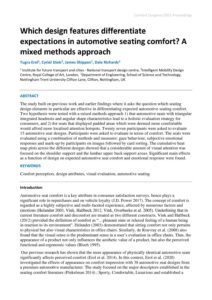 |
Author
Tugra Erol, Cyriel Diels, James Shippen & Dale Richards |
Abstract
The study built on previous work and earlier findings where it asks the question which seating design elements in particular are effective in differentiating expected automotive seating comfort. Two hypothesis were tested with a mixed methods approach 1) that automotive seats with triangular integrated headrests and angular shape characteristics lead to a holistic evaluation strategy for consumers, and 2) for seats that displayed padded areas which were deemed more comfortable would afford more localised attention hotspots. Twenty seven participants were asked to evaluate 15 automotive seat designs. Participants were asked to evaluate in terms of comfort. The seats were evaluated using a combination of methods and measures: gaze behaviour, subjective emotional responses and mark-up by participants on images followed by card sorting. The cumulative heat map plots across the different designs showed that a considerable amount of visual attention was focused on the shoulder support and the lumbar upper back support areas. Significant main effects as a function of design on expected automotive seat comfort and emotional response were found. |
Publish Date: Aug 10, 2021 | Keywords: Aviation, Comfort, Comfort Congress 2021, Publications, Seating
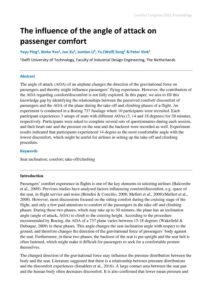 |
Author
Yayu Ping, Xinhe Yao, Jun Xu, Juntian Li, Yu (Wolf) Song & Peter Vink |
Abstract
The angle of attack (AOA) of an airplane changes the direction of the gravitational force on passengers and thereby might influence passengers’ flying experience. However, the contribution of the AOA regarding comfort/discomfort is not fully explored. In this paper, we aim to fill this knowledge gap by identifying the relationships between the perceived comfort/ discomfort of passengers and the AOA of the plane during the take-off and climbing phases of a flight. An experiment is conducted in a Boeing 737 fuselage where 10 participants were recruited. Each participant experiences 3 setups of seats with different AOAs (3, 14 and 18 degrees) for 20 minutes, respectively. Participants were asked to complete several sets of questionnaires during each session, and their heart rate and the pressure on the seat and the backrest were recorded as well. Experiment results indicated that participants experienced 14-degree as the most comfortable angle with the lowest discomfort, which might be useful for airlines in setting up the take-off and climbing procedure. |
Publish Date: Aug 19, 2021 | Keywords: Accessibility, Aviation, Comfort, Comfort Congress 2021, Publications
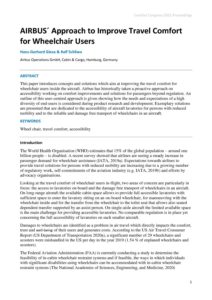 |
Author
Hans-Gerhard Giesa & Ralf Schliwa |
Abstract
This paper introduces concepts and solutions which aim at improving the travel comfort for wheelchair users inside the aircraft. Airbus has historically taken a proactive approach on accessibility working on comfort improvements and solutions for passengers beyond regulation. An outline of this user-centred approach is given showing how the needs and expectations of a high diversity of end-users is considered during product research and development. Exemplary solutions are presented that are dedicated to the accessibility of aircraft lavatories for persons with reduced mobility and to the reliable and damage free transport of wheelchairs in an aircraft. |
Publish Date: Aug 6, 2021 | Keywords: Comfort, Comfort Congress 2021, Publications, Simulation
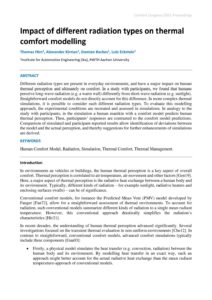 |
Author
Thomas Hirn, Alexander Kirmas, Damian Backes & Lutz Eckstein |
Abstract
Different radiation types are present in everyday environments, and have a major impact on human thermal perception and ultimately on comfort. In a study with participants, we found that humans perceive long-wave radiation (e.g. a warm wall) differently from short-wave radiation (e.g. sunlight). Straightforward comfort models do not directly account for this difference. In more complex thermal simulations, it is possible to consider such different radiation types. To evaluate this modelling approach, the experimental conditions are recreated and assessed in simulations. In analogy to the study with participants, in the simulation a human manikin with a comfort model predicts human thermal perception. Then, participants’ responses are contrasted to the comfort model predictions. Comparison of simulated and participant-reported results allow identification of deviations between the model and the actual perception, and thereby suggestions for further enhancements of simulations are derived. |
Publish Date: Jun 23, 2022 | Keywords: Comfort, Contemporary EHF 2022, Healthcare, Publications
| Document
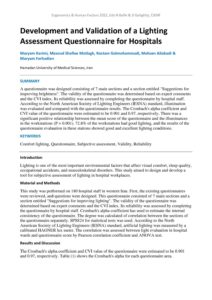
|
Author
Maryam Karimi, Masoud Shafiee Motlagh, Rostam Golmohammadi, Mohsen Aliabadi & Maryam Farhadian |
Abstract
A questionnaire was designed consisting of 7 main sections and a section entitled "Suggestions for improving brightness". The validity of the questionnaire was determined based on expert comments and the CVI index. Its reliability was assessed by completing the questionnaire by hospital staff. According to the North American Society of Lighting Engineers (IESNA) standard, illumination was evaluated and compared with the questionnaire results. The Cronbach's alpha coefficient and CVI value of the questionnaire were estimated to be 0.901 and 0.97, respectively. There was a significant positive relationship between the mean score of the questionnaire and the illuminances in the workstations (P = 0.001). 72.8% of the workstations had good lighting, and the results of the questionnaire evaluation in these stations showed good and excellent lighting conditions. |
Publish Date: Aug 9, 2021 | Keywords: Aviation, Comfort, Comfort Congress 2021, Publications, Seating
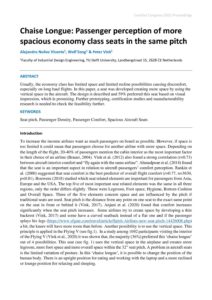 |
Author
Alejandro Nuñez Vicente, Wolf Song & Peter Vink |
Abstract
Usually, the economy class has limited space and limited recline possibilities causing discomfort, especially on long haul flights. In this paper, a seat was developed creating more space by using the vertical space in the aircraft. The design is described and 59% preferred this seat based on visual impression, which is promising. Further prototyping, certification studies and manufacturability research is needed to check the feasibility further. |
Publish Date: Aug 16, 2021 | Keywords: Comfort, Comfort Congress 2021, Pandemic, Publications
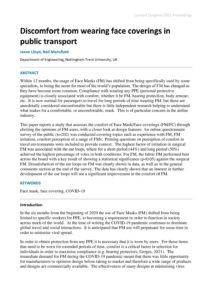 |
Author
Jaxon Lloyd, Neil Mansfield |
Abstract
Within 12 months, the usage of Face Masks (FM) has shifted from being specifically used by some specialists, to being the norm for most of the world’s population. The design of FM has changed as they have become more common. Compliance with wearing any PPE (personal protective equipment) is closely associated with comfort, whether it be FM, hearing protection, body armour, etc. It is now normal for passengers to travel for long periods of time wearing FM, but these are anecdotally considered uncomfortable but there is little independent research helping to understand what makes for a comfortable, or uncomfortable, mask. This is of particular concern in the airline industry. This paper reports a study that assesses the comfort of Face Mask/Face coverings (FM/FC) through eliciting the opinions of FM users, with a closer look at design features. An online questionnaire survey of the public (n=202) was conducted covering topics such as experience with FM, FM irritation, comfort perception of a range of FMs. Priming questions on perception of comfort in travel environments were included to provide context.. The highest factor of irritation in surgical FM was associated with the ear loops, where for a short period (44%) and long period (50%) achieved the highest percentage of votes in both conditions. For FM, the fabric FM performed best across the board with a key result of showing a statistical significance (p |
Publish Date: Aug 9, 2021 | Keywords: Automotive, Autonomous systems, Autonomous vehicles, Comfort, Comfort Congress 2021, Design, Publications
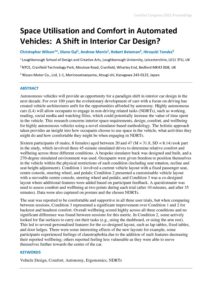 |
Author
Christopher Wilson, Diane Gyi, Andrew Morris, Robert Bateman, Hiroyuki Tanaka |
Abstract
Autonomous vehicles will provide an opportunity for a paradigm shift in interior car design in the next decade. For over 100 years the evolutionary development of cars with a focus on driving has created vehicle architectures unfit for the opportunities afforded by autonomy. Highly autonomous cars (L4) will allow occupants to engage in non-driving related tasks (NDRTs), such as working, reading, social media and watching films, which could potentially increase the value of time spent in the vehicle. This research concerns interior space requirements, design, comfort, and wellbeing for highly autonomous vehicles using a novel simulator-based methodology. The holistic approach taken provides an insight into how occupants choose to use space in the vehicle, what activities they might do and how comfortable they might be when engaging in NDRTs. Sixteen participants (8 males, 8 females) aged between 20 and 47 (M = 31.8, SD = 8.14) took part in the study, which involved three 45-minute simulated drives to determine relative comfort and wellbeing across three different conditions. A bespoke simulator buck was designed and built, and a 270-degree simulated environment was used. Occupants were given freedom to position themselves in the vehicle within the physical restrictions of each condition (including seat rotation, recline and seat height adjustment). Condition 1 involved a current vehicle layout with a fixed passenger seat, centre console, steering wheel, and pedals; Condition 2 presented a customisable vehicle layout with a moveable centre console, steering wheel and pedals; and Condition 3 was a co-designed layout where additional features were added based on participant feedback. A questionnaire was used to assess comfort and wellbeing at two points during each trial (after 10 minutes, and after 35 minutes). Data were also captured on posture and the chosen NDRTs. The seat was reported to be comfortable and supportive in all three user trials, but when comparing between sessions, Condition 3 represented a significant improvement over Condition 1 and 2 for backrest and headrest comfort. Overall wellbeing scored highly across all three conditions and no significant difference was found between sessions for this metric. In Condition 2, some actively looked for flat surfaces to carry out their tasks (e.g., using the dashboard, or using the arm rest). This led to several personalised features for the co-designed layout, such as lap tables, fixed tables, and door ledges. There were some interesting effects of the new layouts for example, some participants experienced feelings of claustrophobia due to the addition of such features decreasing their reported wellbeing; others reported feeling less vulnerable as they were able to move themselves further towards the centre of the car. |
Publish Date: Aug 11, 2021 | Keywords: Automotive, Autonomous vehicles, Comfort, Comfort Congress 2021, Publications, Seating
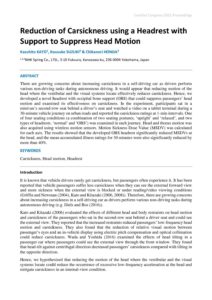 |
Author
Kazuhito Kato, Kousuke Suzuki & Chikanori Honda |
Abstract
There are growing concerns about increasing carsickness in a self-driving car as drivers perform various non-driving tasks during autonomous driving. It would appear that reducing motion of the head where the vestibular and the visual systems locate effectively reduces carsickness. Hence, we developed a novel headrest with occipital bone support (OBS) that could suppress passengers’ head motion and examined its effectiveness on carsickness. In the experiment, participants sat in a minivan’s second-row seat behind a driver’s seat and watched a video on a tablet terminal during a 30-minute vehicle journey on urban roads and reported the carsickness ratings at 1-min intervals. One of four seating conditions (a combination of two seating postures, ‘upright’ and ‘relaxed’, and two types of headrests, ‘normal’ and ‘OBS’) was examined in each journey. Head and thorax motion was also acquired using wireless motion sensors. Motion Sickness Dose Value (MSDV) was calculated for each axis. The results showed that the developed OBS headrest significantly reduced MSDVs at the head, and the mean accumulated illness ratings for 30 minutes were also significantly reduced by more than 40%. |
Publish Date: Aug 6, 2021 | Keywords: Comfort, Comfort Congress 2021, Publications
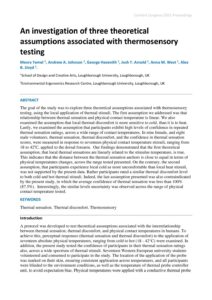 |
Author
Mevra Temel, Andrew A. Johnson, George Havenith, Josh T. Arnold, Anna M. West, Alex B. Lloyd |
Abstract
The goal of the study was to explore three theoretical assumptions associated with thermosensory testing, using the local application of thermal stimuli. The first assumption we addressed was that relationship between thermal sensation and physical contact temperature is linear. We also examined the assumption that local thermal discomfort is more sensitive to cold, than it is to heat. Lastly, we examined the assumption that participants exhibit high levels of confidence in repeated thermal sensation ratings, across a wide range of contact temperatures. In nine female, and eight male volunteers, thermal sensation, thermal discomfort, and the confidence in thermal sensation scores, were measured in response to seventeen physical contact temperature stimuli, ranging from 18 to 42oC, applied to the dorsal forearm. Our findings demonstrated that the first theoretical assumption, that local thermal sensations are linearly related to the stimulus temperature, is true. This indicates that the distance between the thermal sensation anchors is close to equal in terms of physical temperatures changes, across the range tested presented. On the contrary, the second assumption, that participants experience local cold as more uncomfortable than local heat stimuli, was not supported by the present data. Rather participants rated a similar thermal discomfort level to both cold and hot thermal stimuli. Indeed, the last assumption presented was also contraindicated by the present study, in which the average confidence of thermal sensation was less than 100% (87.5%). Interestingly, the similar levels uncertainty was observed across the range of physical contact temperature tested. |
Publish Date: Aug 9, 2021 | Keywords: Aviation, Comfort, Comfort Congress 2021, Design, Publications, Transportation
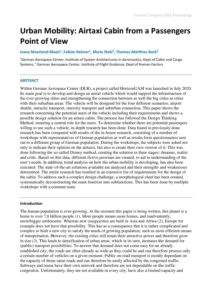 |
Author
Ivana Moerland-Masic, Fabian Reimer, Maria Stolz, Thomas-Matthias Bock |
Abstract
Within German Aerospace Center (DLR), a project called HorizonUAM was launched in July 2020. Its main goal is to develop and design an aerial vehicle which would support the infrastructure of the ever-growing cities and strengthening the connection between as well the big cities as cities with their suburban areas. The vehicle will be designed for the four different scenarios: airport shuttle, intracity transport, intercity transport and suburban connection. This paper shows the research concerning the potential users of the vehicle including their requirements and shows a possible design solution for an airtaxi cabin. The process has followed the Design Thinking Method, ensuring a central role for the users. To determine whether there are potential passengers willing to use such a vehicle, in-depth research has been done. Data found in previously done research has been compared with results of the in-house research, consisting of a number of workshops with representatives of German population as well as results form questionnaires sent out to a different group of German population. During the workshops, the subjects were asked not only to indicate their opinion on the airtaxis, but also to create their own version of it. This was done following the so-called Disney method, creating the solution in three stages: dreamer, realist and critic. Based on this data, different fictive personas are created, to aid in understanding of the user’s needs. In addition, trend analysis on how the urban mobility is developing, has also been executed. The state-of-the-art solutions available are analyzed and their strengths and weaknesses determined. The entire research has resulted in an extensive list of requirements for the design of the cabin. To address such a complex design challenge, a morphological chart has been created, systematically deconstructing the main function into subfunctions. This has been done by multiple workshops with a constant team. |
Publish Date: Aug 18, 2021 | Keywords: Comfort, Comfort Congress 2021, Publications
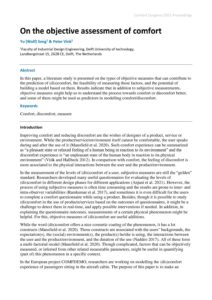 |
Author
Yu (Wolf) Song & Peter Vink |
Abstract
In this paper, a literature study is presented on the types of objective measures that can contribute to the prediction of (dis)comfort, the feasibility of measuring those factors, and the potential of building a model based on them. Results indicate that in addition to subjective measurements, objective measures might help us to understand the process towards comfort or discomfort better, and some of them might be used as predictors in modelling comfort/discomfort. |
Publish Date: May 30, 2024 | Keywords: Comfort, Contemporary EHF 2024, Human factors integration, Human performance, Human-machine interaction, Publications
| Document
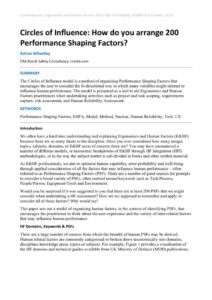
|
Author
Adrian Wheatley |
Abstract
The Circles of Influence model is a method of organising Performance Shaping Factors that encourages the user to consider the bi-directional way in which many variables might interact to influence human performance. The model is presented as a tool to aid Ergonomics and Human Factors practitioners when undertaking activities such as project and task scoping, requirements capture, risk assessment, and Human Reliability Assessment. |
Publish Date: May 30, 2024 | Keywords: Aviation, Comfort, Contemporary EHF 2024, Publications
| Document
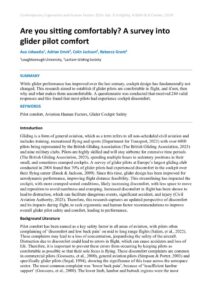
|
Author
Ava Udwadia1, Adrian Emck2, Colin Jackson2, Rebecca Grant1 |
Abstract
While glider performance has improved over the last century, cockpit design has fundamentally not changed. This research aimed to establish if glider pilots are comfortable in flight, and if not, then why and what makes them uncomfortable. A questionnaire was conducted that received 244 valid responses and this found that most pilots had experience cockpit discomfort. |
Publish Date: Aug 19, 2021 | Keywords: Aviation, Comfort, Comfort Congress 2021, Design, Publications, Seating
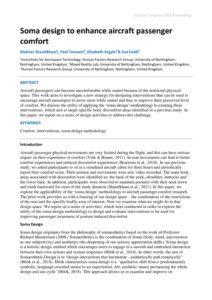 |
Author
Mahnaz Sharafkhani, Paul Tennen2, Elizabeth Argyle & Sue Cobb |
Abstract
Aircraft passengers can become uncomfortable while seated because of the restricted physical space. This work aims to investigate a new strategy for designing interventions that can be used to encourage aircraft passengers to move more while seated and thus to improve their perceived level of comfort. We discuss the utility of applying the ‘soma design’ methodology to creating these interventions, which aim to target specific body discomfort areas identified in a previous study. In this paper, we report on a series of design activities to address this challenge. |
Publish Date: Aug 18, 2021 | Keywords: Aviation, Comfort, Comfort Congress 2021, Musculoskeletal, Publications, Seating
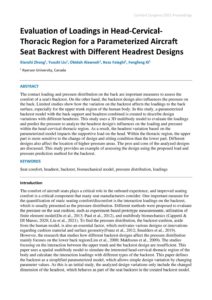 |
Author
Xianzhi Zhong, Yuezhi Liu, Obidah Alawneh, Reza Faieghi & Fengfeng Xi |
Abstract
The contact loading and pressure distribution on the back are important measures to assess the comfort of a seat's backrest. On the other hand, the backrest design also influences the pressure on the back. Limited studies show how the variation on the backrest affects the loadings to the back surface, especially for the upper trunk region of the human body. In this study, a parameterized backrest model with the back support and headrest combined is created to describe design variations with different headrests. This study uses a 3D multibody model to evaluate the loadings and predict the pressure to analyze the headrest design's influences on the loading and pressure within the head-cervical-thoracic region. As a result, the headrest variation based on the parameterized model impacts the supportive load on the head. Within the thoracic region, the upper part is more sensitive to the change of design and sitting condition than the lower part. Different designs also affect the location of higher-pressure areas. The pros and cons of the analyzed designs are discussed. This study provides an example of assessing the design using the proposed load and pressure prediction method for the backrest. |
Publish Date: Aug 12, 2021 | Keywords: Comfort, Comfort Congress 2021, Education, training & skills, Publications
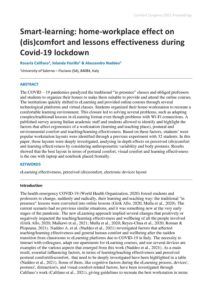 |
Author
Rosaria Califano, Iolanda Fiorillo & Alessandro Naddeo |
Abstract
The COVID – 19 pandemics paralyzed the traditional “in presence” classes and obliged professors and students to organize their homes to make them suitable to provide and attend the online courses. The institutions quickly shifted to eLearning and provided online courses through several technological platforms and virtual classes. Students organized their home-workstation to recreate a comfortable learning environment. This closure led to solving several problems, such as adapting complex/traditional lessons in eLearning format even though problems with Wi-Fi connections. A published survey among Italian academic staff and students allowed to identify and highlight the factors that affect ergonomics of a workstation (learning and teaching place), postural and environmental comfort and teaching/learning effectiveness. Based on these factors, students’ most popular workstation layouts were identified through a previous experiment with 32 students. In this paper, those layouts were deeply investigated, analysing in-depth effects on perceived (dis)comfort and learning effectiveness by considering anthropometric variability and body postures. Results showed that the best layout in terms of postural comfort, visual comfort and learning effectiveness is the one with laptop and notebook placed frontally. |
Publish Date: Aug 9, 2021 | Keywords: Comfort, Comfort Congress 2021, Publications, Transportation
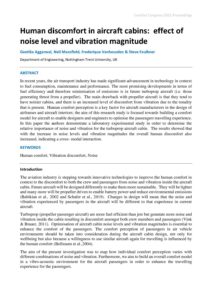 |
Author
Geetika Aggarwal, Neil Mansfield, Frederique Vanheusden & Steve Faulkner |
Abstract
In recent years, the air transport industry has made significant advancement in technology in context to fuel consumption, maintenance and performance. The most promising developments in terms of fuel efficiency and therefore minimisation of emissions is in future turboprop aircraft (i.e. those generating thrust from a propeller). The main drawback with propeller aircraft is that they tend to have noisier cabins, and there is an increased level of discomfort from vibration due to the tonality that is present. Human comfort perception is a key factor for aircraft manufacturers in the design of airframes and aircraft interiors; the aim of this research study is focused towards building a comfort model for aircraft to enable designers and engineers to optimise the passengers travelling experience. In this paper the authors demonstrate a laboratory experimental study in order to determine the relative importance of noise and vibration for the turboprop aircraft cabin. The results showed that with the increase in noise levels and vibration magnitudes the overall human discomfort also increased, indicating a cross- modal interaction. |
Publish Date: Aug 10, 2021 | Keywords: Aviation, Comfort, Comfort Congress 2021, Publications, Seating
 |
Author
Xinhe Yao, Yufei He, Norbert Hessenberger, Yu Song & Peter Vink |
Abstract
During a flight, passengers spend most of their time sitting in their seats. Studying the comfort and discomfort while passengers are sitting is helpful to improve the overall comfort during a flight. Pressure mats are commonly used in studies to collect pressure distribution in order to research sitting comfort. Different from most past studies, in which pressure mats are placed on the top of the cushions, the focus of this paper is to show the potential of placing pressure mat below the seat cushion. Three identical cushions differing in stiffness were prepared. The pressure distribution of 12 sitting postures was collected from 33 subjects both at the top as well as at the bottom of the foam in a randomized order. After sitting on each cushion, the participant was asked to leave the seat and complete a sitting comfort and discomfort questionnaire. The results show that the softest cushion got the highest rank in short-term comfort and lowest rank in short-term discomfort. The recorded pressure distributions both on the top and at the bottom of the foam can influence comfort and discomfort. This indicates the potential to use pressure distributions under the foam to evaluate the perceived comfort and discomfort in sitting, which might reduce the intrusive feeling of the participants in comfort studies. |
Publish Date: Aug 12, 2021 | Keywords: Comfort, Comfort Congress 2021, Design, Publications, Rail, Seating
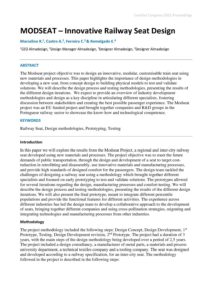 |
Author
Marcelino R., Castro A., Ferreira C. & Remelgado E. |
Abstract
The Modseat project objective was to design an innovative, modular, customisable train seat using new materials and processes. This paper highlights the importance of design methodologies in developing a new seat, from concept design to building physical models to test and validate solutions. We will describe the design process and testing methodologies, presenting the results of the different design iterations. We expect to provide an overview of industry development methodologies and design as a key discipline in articulating different specialists, fostering discussion between stakeholders and creating the best possible passenger experience. The Modseat project was an EU funded project and brought together companies and R&D groups in the Portuguese railway sector to showcase the know-how and technological competence. |
Publish Date: Aug 16, 2021 | Keywords: Clothing, Comfort, Comfort Congress 2021, Publications
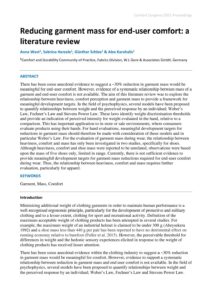 |
Author
Anna West, Sabrina Herzele, Günther Schlee & Alex Karahalis |
Abstract
There has been some anecdotal evidence to suggest a ~30% reduction in garment mass would be meaningful for end-user comfort. However, evidence of a systematic relationship between mass of a garment and end-user comfort is not available. The aim of this literature review was to explore the relationship between heaviness, comfort perception and garment mass to provide a framework for meaningful development targets. In the field of psychophysics, several models have been proposed to quantify relationships between weight and the perceived response by an individual; Weber’s Law, Fechner’s Law and Stevens Power Law. These laws identify weight discrimination thresholds and provide an indication of perceived intensity for weight evaluated in the hand, relative to a comparison. This has important application to in-store or sale environments, where consumers evaluate products using their hands. For hand evaluations, meaningful development targets for reductions in garment mass should therefore be made with consideration of these models and in particular Weber’s Law. For the evaluation of garment mass during wear, the relationship between heaviness, comfort and mass has only been investigated in two studies, specifically for shoes. Although heaviness, comfort and shoe mass were reported to be unrelated, observations were based upon the mass of five shoes only, limited in range. Currently, there is not sufficient evidence to provide meaningful development targets for garment mass reductions required for end-user comfort during wear. Thus, the relationship between heaviness, comfort and mass requires further evaluation, particularly for apparel. |
Publish Date: Aug 9, 2021 | Keywords: Automotive, Autonomous vehicles, Comfort, Comfort Congress 2021, Mental health & wellbeing, Publications
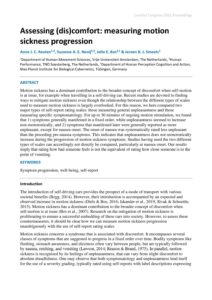 |
Author
Anna J. C. Reuten, Suzanne A. E. Nooij, Jelte E. Bos & Jeroen B. J. Smeets |
Abstract
Motion sickness has a dominant contribution to the broader concept of discomfort when self-motion is at issue, for example when travelling in a self-driving car. Recent studies are devoted to finding ways to mitigate motion sickness even though the relationship between the different types of scales used to measure motion sickness is largely overlooked. For this reason, we here compared two major types of self-report rating scales: those measuring general unpleasantness and those measuring specific symptomatology. For up to 30 minutes of ongoing motion stimulation, we found that 1) symptoms generally manifested in a fixed order, while unpleasantness seemed to increase non-monotonically, and 2) symptoms that manifested later were generally reported as more unpleasant, except for nausea onset. The onset of nausea was systematically rated less unpleasant than the preceding pre-nausea symptoms. This indicates that unpleasantness does not monotonically increase during the progression of motion sickness symptoms. Studies having used the two different types of scales can accordingly not directly be compared, particularly at nausea onset. Our results imply that rating how bad someone feels is not the equivalent of rating how close someone is to the point of vomiting. |
Publish Date: Sep 7, 2019 | Keywords: Automotive, Comfort, Contemporary EHF 2019, Publications
| Document
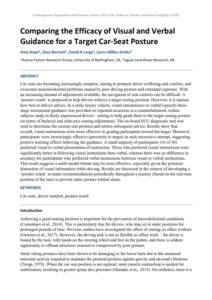
|
Author
Amy Hope, Gary Burnett, David R Large, Laura Millen-Dutka |
Abstract
Car seats are becoming increasingly complex, aiming to promote driver wellbeing and comfort, and overcome musculoskeletal problems caused by poor driving posture and extended exposure. With an increasing amount of adjustments available, the navigation of seat controls can be difficult. A ‘posture coach’ is proposed to help drivers achieve a target seating position. However, it is unclear how best to deliver advice. In a static luxury vehicle, visual (animations) or verbal (speech) three-stage incremental guidance was provided on repeated occasions in a counterbalanced, within-subjects study to thirty experienced drivers - aiming to help guide them to the target seating posture (in terms of backrest and slide-axis seating adjustment). The on-board ECU diagnostic tool was used to determine the current seat position and inform subsequent advice. Results show that, overall, visual instructions were more effective in guiding participants toward the target. Moreover, participants were increasingly effective (proximity to target) in each successive attempt, suggesting positive learning effects following the guidance. A small majority of participants (16 of 30) preferred visual to verbal presentation of instruction. Those who preferred visual instructions were significantly better at following visual instructions than verbal, whereas there was no difference in accuracy for participants who preferred verbal instructions between visual or verbal instructions. This result suggests a multi-modal format may be most effective, especially given the potential distraction of visual information while driving. Results are discussed in the context of developing a ‘posture coach’ to make recommendations periodically throughout a journey (based on the real-time position of the seat) to prevent static posture-related strain. |
Publish Date: Jun 23, 2022 | Keywords: Accessibility, Comfort, Contemporary EHF 2022, Healthcare, Patient Safety, Publications
| Document
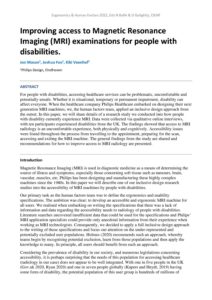
|
Author
Jon Mason, Joshua Fox & Kiki Veenhof |
Abstract
For people with disabilities, accessing healthcare services can be problematic, uncomfortable and potentially unsafe. Whether it is situational, temporary or permanent impairment, disability can affect everyone. When the healthcare company Philips Healthcare embarked on designing their next generation MRI machines, we, the human factors team, applied an inclusive design approach from the outset. In this paper, we will share details of a research study we conducted into how people with disability currently experience MRI. Data were collected via qualitative online interviews, with ten participants experienced disabilities from the UK. The findings showed that access to MRI radiology is an uncomfortable experience, both physically and cognitively. Accessibility issues were found throughout the process from travelling to the appointment, preparing for the scan, accessing and exiting the MRI machine. The general findings from the study are shared and recommendations for how to improve access to MRI radiology are presented. |
Publish Date: Jun 12, 2023 | Keywords: Anthropometry, Comfort, Contemporary EHF 2023, Education, training & skills, Publications, Safety, Seating
| Document
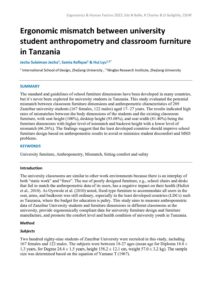
|
Author
Jecha Suleiman Jecha, Samia Rafique & Hui Lyu |
Abstract
The standard and guidelines of school furniture dimensions have been developed in many countries, but it’s never been explored for university students in Tanzania. This study evaluated the potential mismatch between classroom furniture dimensions and anthropometric characteristics of 289 Zanzibar university students (167 females, 122 males) aged 17- 27 years. The results indicated high rates of mismatches between the body dimensions of the students and the existing classroom furniture, with seat height (100%), desktop height (93.08%), and seat width (81.40%) being the furniture dimensions with higher level of mismatch and backrest height with a lower level of mismatch (66.26%). The findings suggest that the least developed countries should improve school furniture design based on anthropometric results to avoid or minimize student discomfort and MSD problems. |
Publish Date: Aug 12, 2021 | Keywords: Aviation, Comfort, Comfort Congress 2021, Fatigue & sleep, Publications
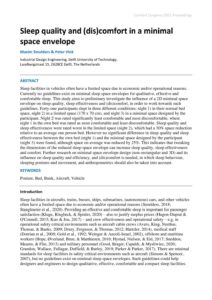 |
Author
Maxim Smulders & Peter Vink |
Abstract
Sleep facilities in vehicles often have a limited space due to economic and/or operational reasons. Currently no guidelines exist on minimal sleep space envelopes for qualitative, effective and comfortable sleep. This study aims to preliminary investigate the influence of a 2D minimal space envelope on sleep quality, sleep effectiveness and (dis)comfort, in order to work towards such guidelines. Forty-one participants slept in three different conditions: night 1) in their normal bed space, night 2) in a limited space (170 x 70 cm), and night 3) in a minimal space designed by the participant. Night 2 was rated significantly least comfortable and most discomfortable, where night 1 in the own bed was rated as most comfortable and least discomfortable. Sleep quality and sleep effectiveness were rated worst in the limited space (night 2), which had a 30% space reduction relative to an average one person bed. However no significant difference in sleep quality and sleep effectiveness between the own bed (night 1) and the minimal space designed by the participant (night 3) were found, although space on average was reduced by 25%. This indicates that tweaking the dimensions of the reduced sleep space envelope can increase sleep quality, sleep effectiveness and comfort. Further research on minimal space envelope design (non-rectangular and 3D) and its influence on sleep quality and efficiency, and (dis)comfort is needed, in which sleep behaviour, sleeping postures and movement, and anthropometrics should also be taken into account. |
Publish Date: Aug 6, 2021 | Keywords: Comfort, Comfort Congress 2021, Equality, diversity & inclusion (EDI), Publications
| Document
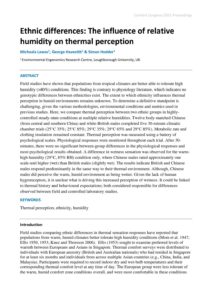
|
Author
Micheala Lawes, George Havenith & Simon Hodder |
Abstract
A protocol was developed to test theoretical assumptions associated with the interrelationship between thermal sensation, thermal discomfort, and physical contact temperatures in humans. To achieve this, perceptual responses (thermal sensation and thermal discomfort) to the application of seventeen absolute physical temperatures, ranging from cold to hot (18 - 42°C) were examined. In addition, the present study tested the confidence of participants in their thermal sensation ratings also, across a wide spectrum of thermal stimuli. Seventeen Western European university students volunteered and consented to participate in the study. The location of the application of the probe was marked on their skin, ensuring consistent application across temperatures, and all participants were blinded to the environment conditions, as well as the temperature of thermal probe controller unit, to avoid expectation bias. Physical temperatures were applied with a conductive thermal probe (Physitemp Instruments Inc., USA) consisting of a 25 cm2 metal surface, applied with a pressure of 4 kPa, in a mixed counterbalanced order. The probe was applied to the skin for 10 seconds for all applications, at the end of which participants rated their local thermal sensation, the confidence of thermal sensation, and local thermal discomfort. A recovery time between thermal probe applications of at least 20 seconds was used. Local skin temperature has been reported to have returned to its baseline value using a single spot infrared thermometer (FLUKE 566, Fluke Corporation, USA) prior to each subsequent thermal probe application. |
Publish Date: Aug 9, 2021 | Keywords: Comfort, Comfort Congress 2021, Human performance, Publications, Task analysis
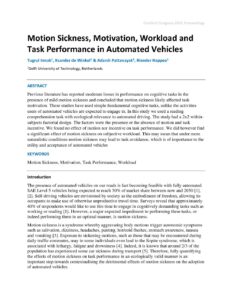 |
Author
Tugrul Irmak, Ksander de Winkel1 & Adarsh Pattanayak, Riender Happee |
Abstract
Previous literature has reported moderate losses in performance on cognitive tasks in the presence of mild motion sickness and concluded that motion sickness likely affected task motivation. These studies have used simple fundamental cognitive tasks, unlike the activities users of automated vehicles are expected to engage in. In this study we used a reading comprehension task with ecological relevance to automated driving. The study had a 2x2 within-subjects factorial design. The factors were the presence or the absence of motion and task incentive. We found no effect of motion nor incentive on task performance. We did however find a significant effect of motion sickness on subjective workload. This may mean that under more naturalistic conditions motion sickness may lead to task avoidance, which is of importance to the utility and acceptance of automated vehicles. |
Publish Date: Aug 12, 2021 | Keywords: Aviation, Comfort, Comfort Congress 2021, Perception, Publications, User experience
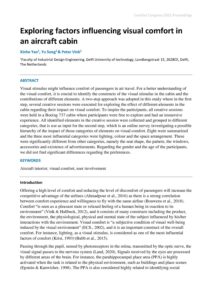 |
Author
Xinhe Yao, Yu Song & Peter Vink |
Abstract
Visual stimulus might influence comfort of passengers in air travel. For a better understanding of the visual comfort, it is crucial to identify the constructs of the visual stimulus in the cabin and the contributions of different elements. A two-step approach was adopted in this study where in the first step, several creative sessions were executed for exploring the effect of different elements in the cabin regarding their impact on visual comfort. To inspire the participants, all creative sessions were held in a Boeing 737 cabin where participants were free to explore and had an immersive experience. All identified elements in the creative session were collected and grouped to different categories, that is use as input for the second step, which is an online survey investigating a possible hierarchy of the impact of those categories of elements on visual comfort. Eight were summarized and the three most influential categories were lighting, colour and the space arrangement. These were significantly different from other categories, namely the seat shape, the pattern, the windows, accessories and existence of advertisements. Regarding the gender and the age of the participants, we did not find significant differences regarding the preferences. |
Publish Date: Aug 16, 2021 | Keywords: Clothing, Comfort, Comfort Congress 2021, Design, Publications
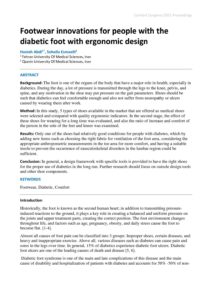 |
Author
Hanieh Abdi, Soheila Esmaeili |
Abstract
Background: The foot is one of the organs of the body that have a major role in health, especially in diabetics. During the day, a lot of pressure is transmitted through the legs to the knee, pelvis, and spine, and any motivation in the shoe may put pressure on the gait parameters. Shoes should be such that diabetics can feel comfortable enough and also not suffer from neuropathy or ulcers caused by wearing them after work. Method: In this study, 5 types of shoes available in the market that are offered as medical shoes were selected and compared with quality ergonomic indicators. In the second stage, the effect of these shoes for wearing for a long time was evaluated, and also the ratio of increase and comfort of the person in the sole of the feet and knees was examined. Results: Only one of the shoes had relatively good conditions for people with diabetes, which by adding new items such as choosing the right fabric for ventilation of the foot area, considering the appropriate anthropometric measurements in the toe area for more comfort, and having a suitable insole to prevent the occurrence of musculoskeletal disorders in the lumbar region could be sufficient. Conclusion: In general, a design framework with specific tools is provided to have the right shoes for the proper use of diabetics in the long run. Further research should focus on outsole design tools and other shoe components. |
Publish Date: Aug 16, 2021 | Keywords: Clothing, Comfort, Comfort Congress 2021, Publications, Tools & techniques
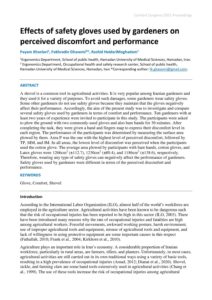 |
Author
Payam Khanlari, Fakhradin Ghasemi, Rashid HeidariMoghadam |
Abstract
A shovel is a common tool in agricultural activities. It is very popular among Iranian gardeners and they used it for a variety of purposes. To avoid such damages, some gardeners wear safety gloves. Some other gardeners do not use safety gloves because they maintain that the gloves negatively affect their performance. Accordingly, the aim of the present study was to investigate and compare several safety gloves used by gardeners in terms of comfort and performance. Ten gardeners with at least two years of experience were invited to participate in this study. The participants were asked to plow the ground with two commonly-used gloves and also bare hands for 30 minutes. After completing the task, they were given a hand and fingers map to express their discomfort level in each region. The performance of the participants was determined by measuring the surface area plowed by them. Area P was the one with the highest level of perceived discomfort, followed by TP, MM, and IM. In all areas, the lowest level of discomfort was perceived when the participants used the cotton glove. The average area plowed by participants with bare hands, cotton gloves, and Latex gloves were 1266cm2 (±112.7), 1230cm2 (±80.4), and 1186cm2 (±138.6), respectively. Therefore, wearing any type of safety gloves can negatively affect the performance of gardeners. Safety gloves used by gardeners were different in terms of the perceived discomfort and performance. |









































